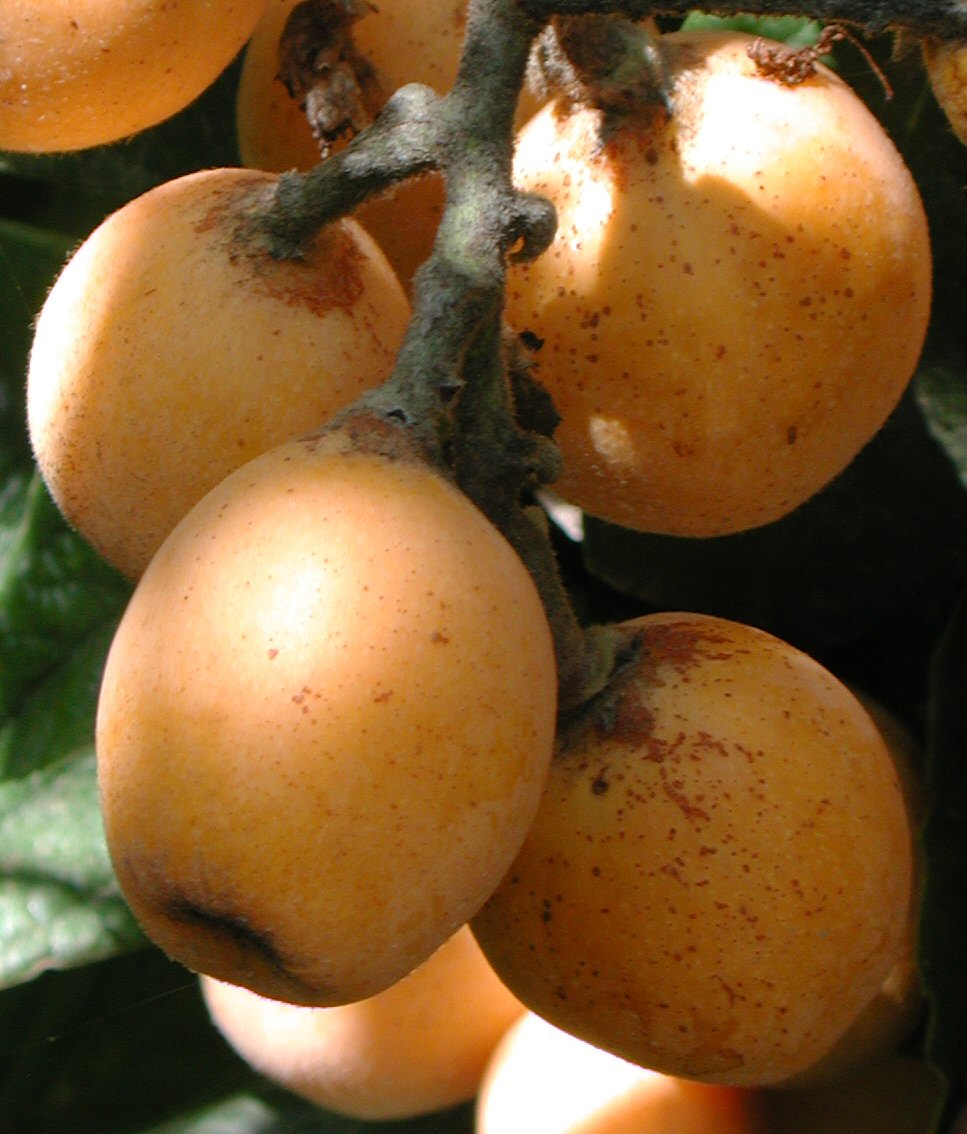
Loquat, exotic local fruit, photo by Loquat World
Heads up, literally: Loquats are ripening. First you will see just an occasional ripe fruit, then noticeably more. Then the fruit flood gate opens. Loquats, planted and naturalized, are a much-anticipated tasty fruit that do not travel well. One rarely sees them in local markets. They bruise easily and begin to lose their bright yellow color within hours of picking. The refrigerator does not treat them well, either. While loquats can be canned I think the best way to preserve this bounty is by dehydration. I cut around the fruit’s equator, remove the seeds for other use, then dry the two halves. Some people dip the halves in a sulfur solution first but I have not found that to improve looks, flavor or preservation. The reason why I recommend dehydrating them is you end up with a delicious product. Some fruits do not dehydrate well, loosing flavor and or texture. Mulberries are a good example. They are best fresh. And while dried loquats don’t taste like fresh loquats — as prunes don’t taste like plums — they are good dehydrated and store well. I have a video on them here and a large article here.
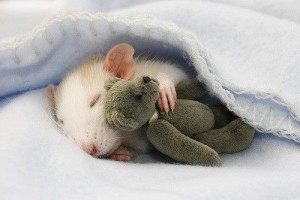
Poison hemlock smells like mice, or do mice smell like poison hemlock? Photo by Favim.com
I had to share this next snippet with you. On the Green Deane Forum a book was mentioned, Weeds of the South. So I ordered it, not expensive. All in all it is a good book written for farmers and livestock breeders et cetera. One distraction is the near-paranoia the writers and editors have over wild edibles, listing most if not all of them as toxic. A bad attitude towards edible weeds is basically institutionalized in the United States. If one can ignore that ugly little entry on each page it’s a good book with excellent descriptions and pictures. Sometimes however the description just misses the mark. Under “special identifying features” for the deadly Poison Hemlock it says: Herbage has a mouse-like odor… Mouse-like odor? Who smells mice? Have you ever smelled a mouse? Do you know anyone who has? I haven’t. That’s the writer and the editor not thinking about the reader. The closest I’ve ever come to smelling a mouse is my grandmother had a pet rat who got a bath with a toothbrush once a week in a warm oven.
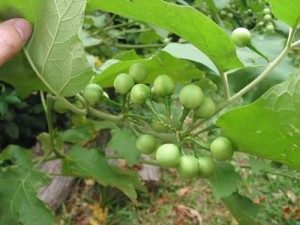
Turkey Berries, photo by GardeningwitjWilson
Showing up in a few back yards in south Florida is the The Turkey Berry, Solanum torvum. It’s an iffy plant. The Turkey Berry has been used for roots stock for eggplants. Its bitter immature fruit are eaten but they might cause liver tumors (Balachandran and Sivaramkrishnan, 1995, Induction of tumors by Indian dietary constituents.). Turkey Berry was first found in Florida in 1899 and is now identified in nine counties. It’s also a weed in 32 countries and is invasive in Australia and South Africa. Armed with spines, it has gray bark, and green pea-sized fruit that ripen to yellow. The half-grown green immature fruits are used in Thai cuisine and are an essential ingredient of Thai yellow curry. In India, the fruit is consumed directly, or as cooked food. Young shoots are eaten raw or cooked. In Jamaica the immature fruit are boiled and eaten. That said the Turkey Berry contains a number of potentially harmful chemicals. And while I could not find any reference about this its fruits might become more toxic as they ripen as the Tropical Soda Apple does. The Turkey Berry’s lobed leaves alternate and are broadly triangular. However there are no thorns on the top part of the leaves. Ripe berries are drab yellow drying to black. A far more edible member of the nightshade family escaped in south Florida and cultivated in northern climes is the Litchi tomato. You can read about it here.
A perennial question on the Green Deane Forum’s UFO page (unidentified flowering objects) is about prickly plants growing what looks like tomatoes. Sometimes the fruit is red, sometimes yellow. The quick answer is “it’s some kind of ‘soda apple’ and not edible.” We could leave the discussion right there but usually people want to know more. At least seven prickly “non-tomatoes” show up regularly on the forum. A few are native, most are imported. To read more about them and help you identify “toxic tomatoes” go here.
February is conference month for me, first the Florida Earth Skills two weeks ago and this past weekend Florida Herbal Conference. I want to thank Emily Ruff for having me as a presenter again. Foraging in Florida in February is a challenge but we found about two dozen species to talk about. I also had the opportunity to chat with Mycol Steven, who organizes the Florida Earth Skills gathering and who also taught at the herbal conference. While these conferences are over for this year, mark your calender for next year and look into attending either or both, as many people do.
I also had the opportunity to hold a class at Lake Woodruff National Wildlife Refuge. I don’t do that too often because it is a long walk, more native than imported edibles, and no facilities. But, it is wet and that creates a different group of plants. We had a large class and good time including seeing quite a few sunning alligators. Lake Woodruff has dikes that are also roads. Thus while we find native edibles in the local woods we find the weeds of man and sun-loving native edibles on the dike roads. One curious distribution was the sow thistles. Spiny Sow Thistle was common on the southwest side of our walk and the Common Sow Thistle on the northeast side of the walk. There were also a lot of bull thistles and ground cherries, American Nightshade, as well as blackberries and dew berries. Definitely a place to visit for snacking in the months to come.
From the positive email: “As a retiree I spent several years as a Passport in Time volunteer with the Forest Service. On one project we were searching for house remains to map a mill village that had existed between 1790 and 1890. After spending much time looking for stone piles and fireplace remains a fellow worker and I were talking about the site when it came to our attention that each of the house sites we had located had had a Osage Orange tree near by. We began looking for the trees instead of the foundations and were very successful. “The Question” why were these people planting this tree? The insect repellent is to date the most logical answer I have been given.”
Conversely I receive regular hate email from turtle lovers because I wrote an article on their edibility. I like turtles other than in a stew and found this story from the Mirror enjoyable:
“Manuela the tortoise has been found alive – after more than 30 years locked in a storeroom. She was finally spotted after being put out for the binmen in a box of rubbish. Manuela, middle-aged for her species, was reunited with her amazed owners as they described her survival as “incredible”.
She vanished from her home in Rio de Janeiro in 1982 and was given up as lost forever despite a lengthy search. Her owners assumed she had crawled away after builders working on the house left the front door open. It was only after their father Leonel Almieda died that his children began clearing out a second-floor room he had filled with broken electrical items and always kept locked. Son Leandro was astonished to find Manuela shuffling around in a cardboard box containing an old record player.
“I put the box on the pavement for the binmen to collect, and a neighbor said, ‘You’re not throwing the tortoise out as well are you?’ I looked and saw Manuela. And at that moment I turned white. I just could not believe what I was seeing.” His sister Lenita, who had been given the tortoise as a childhood pet, said, “Everything my father thought he could fix, he picked up and brought home. If he found an old television he thought he might be able to use a part of it to fix another one in the future, so he just kept accumulating things. We never dared go inside that room. We are all thrilled to have Manuela back. But none of us can understand how she managed to survive for 30 years in there – it’s just unbelievable.”
Local vet Jeferson Pires explained that Manuela is a red-footed tortoise, a species that can go for up to three years without eating. He said she may have survived by nibbling termites from the wooden floor and licking condensation off smooth surfaces. He added: “They are particularly resilient creatures.”
My thought was perhaps dad fed her all those years. Regardless, Manuela is back with the rest of the family who recognized her immediately because they have … (wait for it)… turtle recall.

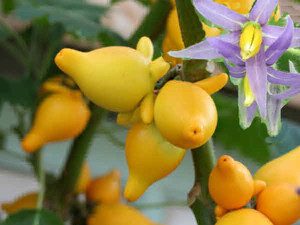
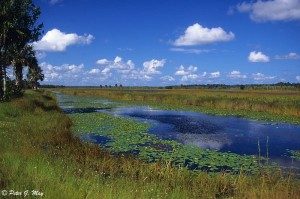
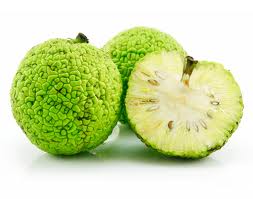



Turtle Recall … lol cute. Thanks again for one more beautiful article. and just for my two cents I think a mouse smells like sawdust and pee. I will have to smell Poison Hemlock to give you my full opinion there. 🙂 Peace, Love and Go Green!
This is unbelievable!!!……I haven’t been keeping up with your wonderful site
I have been occupied with other life events. I am always amazed at all the
Info you share!…Thank You!!!
I had to laugh about the ‘smells like a mouse’ and your comment ‘Have you ever smelled a mouse?’ – in fact I have, albeit unwillingly. I have to empty the traps from the parts of the house where the cats don’t have access, and dead mice have a very distinct odor. If I smelled a plant that resembled this scent I would promptly lose my appetite 😉
As for the dead mice, I have a very simple, practical disposal method your readers might find helpful; if you are in an area with crows, ravens or other omnivorous birds, simply pick a spot well away from your door – I use a spot next to the compost pile – and dump them there. It won’t take long for the clever birds to figure out that you are leaving them a treat 😉
It’s been a while since I smelled a mouse but I’d probably remember… I used to have some laboratory mice in a cage a few years back… Disgusting little things compared to my box turtle and pet toad. Reptiles and amphibians are clean, and as you saw in the tortoise article, don’t need a huge amount of food to survive. I haven’t smelled poison hemlock, but I imagine that if it smelled like mice, no one would ever have been poisoned by it on account that no one would dare eat something with the reeking mouse stench!
Wonderful story.
I was very excited about the mention of the Osage Orange tree. When I was young we used to take campers to the old family homestead in Louisiana and stay there weeks at a time. There was cotton as far as the eye could see, and the homestead was right on the Ouachita River. There was an old plantation home on the other side of the levee facing the river. I remember playing with the Osage “apples” or as we called it “horse/indian apples.” We would make a game out of seeing how far we could throw them. Wonderful memories.
this weeks articles were fun. when I lived in Kansas a town (Eureka) had an annual osage orange chunking contest. i developed and fored several different trebouches and catapaults . great fun and we used the oranges for sent cover and bug repellant when in the woods.
To shed some light under the shadow of the large Osage tree. Here in PA these trees are almost always near farms. Used in hedgerows and outlying areas, they were harvested to make farm implements and fences. The Osage Orange (locally known as Monkey Ball Tree) was/is also a decent wood for crafting. Osage fence posts still stand near my house. My father actually worked the stables at the farm when he was young. One of his earliest memories of this place was an old buckboard loaded to capacity with fence posts cut from local trees. That was 1963. Those very same posts are still there along with the parent trees. I now harvest limbs for my very good friend to do wood working with. He actually has a yoke made from Osage that dates back to early 1900’s. It is beat up and its hardware is terribly corroded but it hangs over his mantel place.
saw turkey berry in broward treetops park horse trails
We were lucky, as we do’nt have loquat rulers or even the trees, our old fashioned teachers used to lash us on our backs with bamboo sticks. It is worthwhile to mention that a more familiar species of the same family,Rosaceae,to the Arab world in general and to Jordan, Syria and Lebanon in particular, is the one called ” Alzarour ” in Arabic; it is Crataegus azarolus. It is mainly used here as herbal medicine for the treatment of diseases related to the blood circulation and the heart especially congestive heart failure. It is thus described as “heart friend”. Loquat fruit is not available here in my country,Sudan, not even in the dehydrated form and it is not marketable,perhaps for the reason of being difficcult to preserve. How unlucky I am not being able to make jam as It has easily been described. By the way is it possible to dehydrate ripe banana which is also difficult to keep in the refrigerater?We really lose considerable amount of it due to difficulty in preservation.
If you slice bananas thin they dehydrate nicely.